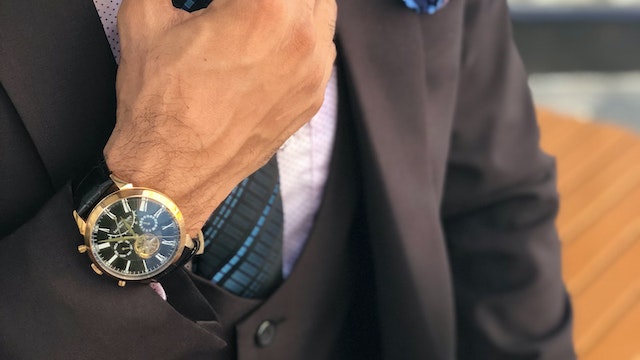Sweater or a suit? Dress or pants? Does your appearance affect how well you speak? How, if so? In this post, we look at appropriate and inappropriate attire for public speakers.

Dress to the standards of your audience
Different speaking circumstances call for different dress codes, but as a rule, you are quite safe if you are neat, clean, and dressed in the same way as your audience. Why? The third pillar of persuasion is ethos, which refers to your credibility. You accentuate your resemblance to your audience to develop ethos.
Dressing similarly to them is a useful technique to accomplish this. How can you determine what your audience will wear, then? Analyze your target audience!
Consider the attire that attendees wore the last time if the location is a recurring conference or setting. Ask the event organizer what the typical dress code is if you are giving a presentation at a location that is unfamiliar to you. Follow the dress code if it is strict!
Pro Tip
This does not require you to dress in the same suit or outfit as the rest of your audience. There is a lot of room for interpretation. The key is to avoid either significantly under or significantly over-dressed. But I have heard I should present myself more formally than my audience?
“It’s important that you appear respectful and professional. They should not notice what you are wearing once you start speaking, though.
According to conventional thinking, you should dress one notch higher than your audience. Why up it a notch?
- To get noticed.
- To be respected?
- To allude to your success and wealth?

None of those are especially compelling justifications for dressing above your target audience. I believe the recommendation to “dress one notch higher” is given to provide you with some insurance if your audience analysis was inaccurate. If the crowd is dressed finer than you anticipated, and you dress one notch higher than your estimated audience dress code, you will still be protected.
Of course, you can arrive overdressed if your estimate is off in the other direction. In either case, I would not worry too much. The most important thing is to appear respectful and professional. They should not notice what you are wearing once you begin speaking, though.
Public Speaking Dress Codes

What would be the opposite of dressing at (or just above) the same level as your audience, if it is a reasonable rule of thumb? The worst thing you can do is dress in a way that draws attention to you—but in the wrong way.
Cyndi Maxey issues the following advice in Speak Up! A Woman’s Guide to Presenting Like a Pro:
- Any topic you focus on will be noticed, usually in a negative way. […] Do you like the way your new wraparound blouse fits with its lower-cut neckline? Your cleavage will be seen, you can bet. As you dress, consider what you are emphasizing. Think about what you can highlight that focuses on your knowledge and professionalism rather than your sexuality.
Action Item
T-shirts featuring slogans are another common no-no, especially if the slogan can offend someone in your audience. Once more, you want people to focus on the words you say rather than the ones on your shirt.
Exception: This can be acceptable if the shirt’s message ties into your presentation. For instance, wearing a “I’m a survivor” t-shirt while speaking to raise money for cancer research may not only be suitable, but also help to establish your credibility.
As previously advised, make sure you arrive neat and organized. If you do not, it could be taken as disrespect for your viewers.
Prepare for Clothing Mishaps and Failures

Nobody wants to have a wardrobe malfunction. Several measures to prevent these unfavorable occurrences include:
- If you are traveling or the presentation is very essential, you might want to have a backup wardrobe. You will need that insurance in case something unexpected occurs before your presentation, like a spill.
- Before your presentation, watch what you eat and drink. Spaghetti sauce with grape juice are not the best ideas.
- Avoid tempting fate by wearing restrictive clothing. Speaking should be a physically demanding activity; therefore, you do not want to trip over a button or shred a seam. (I have witnessed both.)
- Like this, you might want to avoid wearing very loose clothing or accessories that could get stuck in unexpected locations, including on a flip chart stand or a lectern.
- But what if clothes malfunction still occurs despite your best efforts?

Just go with it. If you can, fix it quietly (e.g., an undone button, or an unzipped zipper). You may occasionally be the last one to observe in the space. Simply shrug it off and return to giving your audience value.
When is Going Against the Grain Acceptable?

It may be appropriate for you to disregard all conventional wisdom and draw attention with your wardrobe in some (rare) circumstances. You may consider wearing in (partial) costume that is connected to your theme, as Kristin Arnold advises in Boring to Bravo (the Six Minutes book review). The concept is that a piece of your clothing, or even an item, is used on purpose as a prop.
If you decide to do it, I advise doing it at the beginning of your presentation. You will be dressed “normally” once more by the time you are delivering the impactful messages, allowing the audience to take you seriously.
Additional Speaker Attire Considerations

Beyond how you appear while you are in front of the room, what you are wearing might have an effect. Avoid wearing or accessorizing loudly. If your shirt, jeans, or jewelry constantly draw attention away from your audience, that is not good.
Comfort is also crucial. Wearing excessively uncomfortable clothing or shoes might have a detrimental impact on your energy level and delivery. This is crucial whether you are giving a lengthy keynote or a multi-day course. There is a gray area between respectable attire and pajamas.

Will you have a microphone on you? If so, think about the location of the pin. What movements, gestures, or objects are you planning to use?
How well do they match your outfit? Remove any potentially distracting objects before you are called upon to speak (e.g., ID badges, cell phones, sunglasses, hats)







